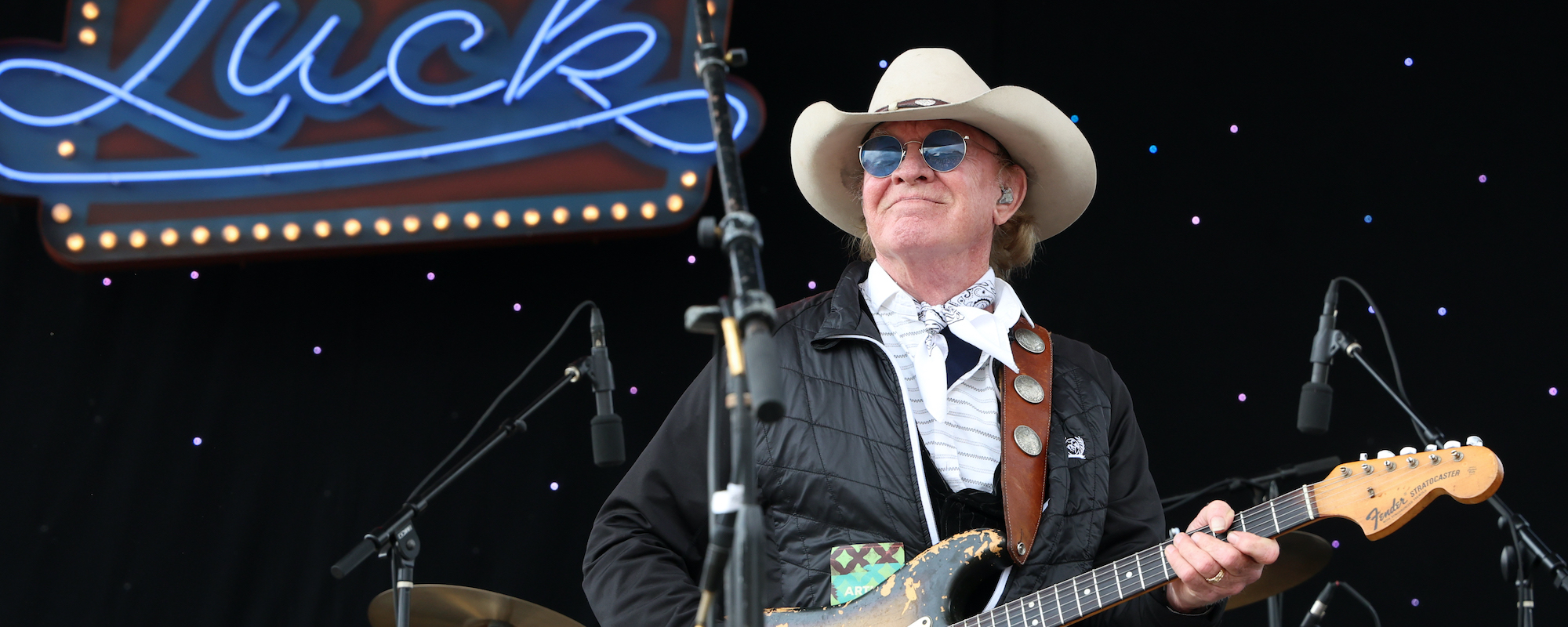The outlaw music legend Waylon Jennings was born as Wayland Jennings in Littlefield, Texas in 1937. He learned to play guitar at 8 and began performing on the radio at 14. The future Country Music Hall of Famer did things his way. This way of life sometimes brought great benefit and great trouble. As he had great success on the charts, he also fought addiction. He was a major force in country music from the late ’60s until he died in 2002. Let’s look at five fascinating facts about Waylon Jennings.
Videos by American Songwriter
Jennings Was a DJ on Multiple Radio Stations
As a child, Jennings listened to the Grand Ole Opry with his father. When he was old enough, he worked at several radio stations, including KDAV and KLLL in Lubbock, Texas. During his time in Lubbock, he crossed paths with Buddy Holly, who was starting a record label.
Jennings Played Bass with Holly
The first artist Holly signed to his new label was Jennings. He recorded “Jole Blon” at producer Norman Petty’s studio in Clovis, New Mexico. The song failed to chart. Holly moved to New York City, while his backup band, The Crickets, chose to stay in Texas. The now solo singer asked Jennings to learn how to play bass to accompany him on the Winter Dance Party Tour.
Jennings discussed Holly in the documentary Waylon Jennings: Renegade, Outlaw, Legend. “He taught me a lot of things in a short period of time,” he said. “About never compromising when it comes to your music. Do what you feel. Buddy seemed like he was trying to tell me everything he could in a short time. Of course, he had no way of knowing what was gonna happen, and I didn’t either.”
After a February 2, 1959 performance at The Surf Ballroom in Clear Lake, Iowa, a plane was chartered for the group to fly to the next stop of the tour. Jennings gave up his seat to The Big Bopper (J.P. Richardson), who was suffering from the flu. When Holly learned Jennings wasn’t making the trip on the plane, he kidded Jennings, “Well, I hope your damned bus freezes up.” Jennings responded, “Well, I hope your ol’ plane crashes.” Jennings was haunted by that exchange for years as the plane never made it to Moorhead, Minnesota, a crash killing all on board.
Chet Atkins Signed Him to RCA Records
In 1961, Jennings moved to Phoenix and played at Frankie’s. He then worked at J.D.’s, where he formed The Waylors. He sang his country, rockabilly, and rock ‘n’ roll. They played six nights a week and found their footing onstage.
Herb Alpert and Jerry Moss of A&M Records signed Jennings to a contract. He put out several songs but had no success on the charts.
Singer/songwriter Bobby Bare gave guitarist Chet Atkins a tip to listen to the young singer. Atkins could see Jennings was a star.
Jennings couldn’t believe it, “‘Cause, you know, Chet Atkins was calling. That’s God’s right hand, as far as country music. When you walk in there, the most important thing in your life is to impress him.”
He did just that. RCA signed Jennings, beginning a professional relationship that would last decades.
Jennings Moved to Nashville and Became Roommates with Johnny Cash
The “Man in Black” had recently separated from his wife Vivian, and the two singers moved into an apartment in the Madison section of Music City. The pair shared a love for music and pills. Jennings auditioned and won the starring role in the movie Nashville Rebel where he played Arlin Grove, a U.S. Army vet who finds himself at odds with the Nashville establishment.
It was about this time when Jennings connected with two important figures in his career, songwriters Harlan Howard and Willie Nelson. Jennings recorded “The Chokin’ Kind” and hit the road hard. His first big hit was “Only Daddy That’ll Walk the Line,” which hit No. 2 on the Billboard Hot Country Songs chart.
In 1970, Atkins moved into an administrative role at RCA, and Jennings was handed off to a revolving door of staff producers. He had a hard time finding his footing. Addiction to pills was his main constant. In 1972, he ended up in the hospital with hepatitis. On the verge of quitting the music business altogether, he gave it one more shot, but with a rock ‘n’ roll approach. Jennings the outlaw was born. The album Honky Tonk Heroes was recorded with Jennings having complete artistic control. A song that had been discarded by a former producer at RCA, “This Time” was his first No. 1 record.
The First Country Album to Sell a Million Copies Was Wanted! The Outlaws
Jennings teamed up with producer Cowboy Jack Clement to record Dreaming My Dreams. “Are You Sure Hank Done it This Way” was another country smash.
Next, he teamed up with Willie Nelson, Tompall Glaser, and his wife Jessi Colter to record an album called Wanted! The Outlaws. It became the first country album to sell over a million copies. “Good Hearted Woman” was rerecorded as a duet with Nelson. This began a string of duets including “Mammas Don’t Let Your Babies Grow Up to Be Cowboys,” “Luckenbach, Texas (Back to the Basics of Love),” “Sittin’ on the Dock of the Bay,” “Take It to the Limit,” and “If I Can Find a Clean Shirt.”
At this time, Jennings moved his center of operations to Texas. He was then busted for cocaine possession. The legal battle dragged on. It had escalated to a $1,500-a-day habit.
Jennings recounted his experience, “When you first do it, yeah, it feels good, you know? It raises you up a little bit. And then, you start chasing the feeling. And that’s what I did for many years. Because I kept doing more and more cocaine, trying to get that first height that I got. But you never do. People say, ‘You’re killing yourself.’ You say, ‘It’s my life, I’ll do what I please. You know, it’s none of your business. It’s my life.’ That’s true. If you want to live out somewhere in a cave where you don’t affect other people’s lives. But you don’t have a right to destroy their lives with what you’re doing wrong.”
Jennings died on February 13, 2002, from complications of diabetes. He was 64.
When you purchase through links on our site, we may earn an affiliate commission.
Photo by David Redfern/Redferns













Leave a Reply
Only members can comment. Become a member. Already a member? Log in.